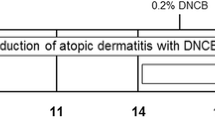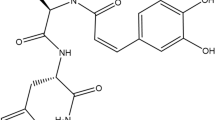Abstract
Purpose
Atopic dermatitis (AD) is a chronically relapsing, pruritic, eczematous skin disorder accompanying allergic inflammation. AD is triggered by oxidative stress and immune imbalance. The effect of oral arjunolic acid (AA) on 2,4-dinitrochlorobenzene (DNCB)-induced atopic dermatitis in mice was investigated.
Methods
Repeated epicutaneous application of DNCB to the ear and shaved dorsal skin of mice was performed to induce AD-like symptoms and skin lesions: 250mg/kg AA was given orally for three weeks to assess its anti-pruritic effects. Serum levels of tumor necrosis factor (TNF)-α, interleukin (IL)-4, IL-6, IL-10, immunoglobulin (Ig)E and caspase-3 were assessed by ELISA.
Results
We found that AA alleviated DNCB-induced AD-like symptoms as quantified by skin lesions, dermatitis score, ear thickness and scratching behavior. Levels of reactive oxygen species in the AA group were significantly inhibited compared with those in the DNCB group. In parallel, AA blocked a DNCBinduced reduction in serum levels of IL-4 and IL-10 associated with an attenuation of DNCB-induced increases in serum TNF-α, IL-6, IgE and caspase-3.
Conclusions
The results indicate that AA suppresses DNCB-induced AD in mice via redox balance and immune modulation, and could be a safe clinical treatment for AD.
Similar content being viewed by others
References
Kim H, Kim JR, Kang H, et al. 7,8,4’-Trihydroxyisoflavone Attenuates DNCB-Induced Atopic Dermatitis-Like Symptoms in NC/Nga Mice. PloS ONE 2014; 9: e104938.
Williams H, Robertson C, Stewart A, et al. Worldwide variations in the prevalence of symptoms of atopic eczema in the International Study of Asthma and Allergies in Childhood. J Allergy Clin Immunol 1999; 103(1 Pt 1): 125–38.
Marsella R, Olivry T, Carlotti DN, International Task Force on Canine Atopic D. Current evidence of skin barrier dysfunction in human and canine atopic dermatitis. Vet Dermatol 2011; 22: 239–48.
Blume-Peytavi U, Wahn U. Optimizing the treatment of atopic dermatitis in children: a reviewof the benefit/risk ratio of methylprednisolone aceponate. J Eur Acad Dermatol Venereol 2011; 25: 508–15.
Hengge UR, Ruzicka T, Schwartz RA, Cork MJ. Adverse effects of topical glucocorticosteroids. J Am Acad Dermatol 2006; 54: 1–15, quiz 16-18.
Ghosh J, Sil PC. Arjunolic acid: a new multifunctional therapeutic promise of alternative medicine. Biochimie 2013; 95: 1098–109.
Al-Gayyar MM, Al Youssef A, Sherif IO, Shams ME, Abbas A. Protective effects of arjunolic acid against cardiac toxicity induced by oral sodium nitrite: effects on cytokine balance and apoptosis. Life Sci 2014; 111: 18–26.
Manna P, Sil PC. Impaired redox signaling and mitochondrial uncoupling contributes vascular inflammation and cardiac dysfunction in type 1 diabetes: Protective role of arjunolic acid. Biochimie 2012; 94: 786–97.
Sherif IO, Abdel-Aziz A, Sarhan OM. Cisplatin-Induced Testicular Toxicity in Rats: The Protective Effect of Arjunolic Acid. J Biochem Mol Toxicol 2014; 28: 515–21.
Tayel A, Abd El Galil KH, Ebrahim MA, Ibrahim AS, El-Gayar AM, Al-Gayyar MM. Suramin inhibits hepatic tissue damage in hepatocellular carcinoma through deactivation of heparanase enzyme. Eur J Pharmacol 2014; 72: 8151–60.
Darweish MM, Abbas A, Ebrahim MA, Al-Gayyar MM. Chemopreventive and hepatoprotective effects of Epigallocatechin-gallate against hepatocellular carcinoma: role of heparan sulfate proteoglycans pathway. J Pharm Pharmacol 2014; 66: 1032–45.
Beutler E, Duron O, Kelly BM. Improved method for the determination of blood glutathione. J Lab Clin Med 1963; 61: 882–8.
Boguniewicz M, Leung DY. Atopic dermatitis: a disease of altered skin barrier and immune dysregulation. Immunol Rev 2011; 242: 233–46.
Yang MH, Ali Z, Khan IA, Khan SI. Anti-inflammatory activity of constituents isolated from Terminalia chebula. Nat Prod Commun 2014; 9: 965–8.
Hemalatha T, Pulavendran S, Balachandran C, Manohar BM, Puvanakrishnan R. Arjunolic acid: a novel phytomedicine with multifunctional therapeutic applications. Indian J Exp Biol 2010; 48: 238–47.
Sivaranjani N, Rao SV, Rajeev G. Role of reactive oxygen species and antioxidants in atopic dermatitis. J Clin Diagn Res 2013; 7: 2683–5.
Bieber T. Atopic dermatitis. N Engl J Med 2008; 358: 1483–94.
Peroni DG, Bodini A, Corradi M, Coghi A, Boner AL, Piacentini GL. Markers of oxidative stress are increased in exhaled breath condensates of children with atopic dermatitis. Br J Dermatol 2012; 166: 839–43.
Ott H, Stanzel S, Ocklenburg C, Merk HF, Baron JM, Lehmann S. Total serum IgE as a parameter to differentiate between intrinsic and extrinsic atopic dermatitis in children. Acta Derm Venereol 2009; 89: 257–61.
Behniafard N, Gharagozlou M, Farhadi E, et al. TNF-alpha single nucleotide polymorphisms in atopic dermatitis. Eur Cytokine Netw 2012; 23: 163–5.
Auriemma M, Vianale G, Amerio P, Reale M. Cytokines and T cells in atopic dermatitis. Eur Cytokine Netw 2013; 24: 37–44.
Arshad SH, Holgate S. The role of IgE in allergen-induced inflammation and the potential for intervention with a humanized monoclonal anti-IgE antibody. Clin Exp Allergy 2001; 31: 1344–51.
Guo LY, Hung TM, Bae KH, et al. Anti-inflammatory effects of schisandrin isolated from the fruit of Schisandra chinensis Baill. Eur J Pharmacol 2008; 591: 293–9.
Pal S, Pal PB, Das J, Sil PC. Involvement of both intrinsic and extrinsic pathways in hepatoprotection of arjunolic acid against cadmium induced acute damage in vitro. Toxicology 2011; 283: 129–39.
Ghosh J, Das J, Manna P, Sil PC. Acetaminophen induced renal injury via oxidative stress and TNF-alpha production: therapeutic potential of arjunolic acid. Toxicology 2010; 268: 8–18.
Author information
Authors and Affiliations
Corresponding author
About this article
Cite this article
Alyoussef, A. Arjunolic acid protects against DNCB-induced atopic dermatitis-like symptoms in mice by restoring a normal cytokine balance. Eur Cytokine Netw 26, 38–45 (2015). https://doi.org/10.1684/ecn.2015.0364
Published:
Issue Date:
DOI: https://doi.org/10.1684/ecn.2015.0364




